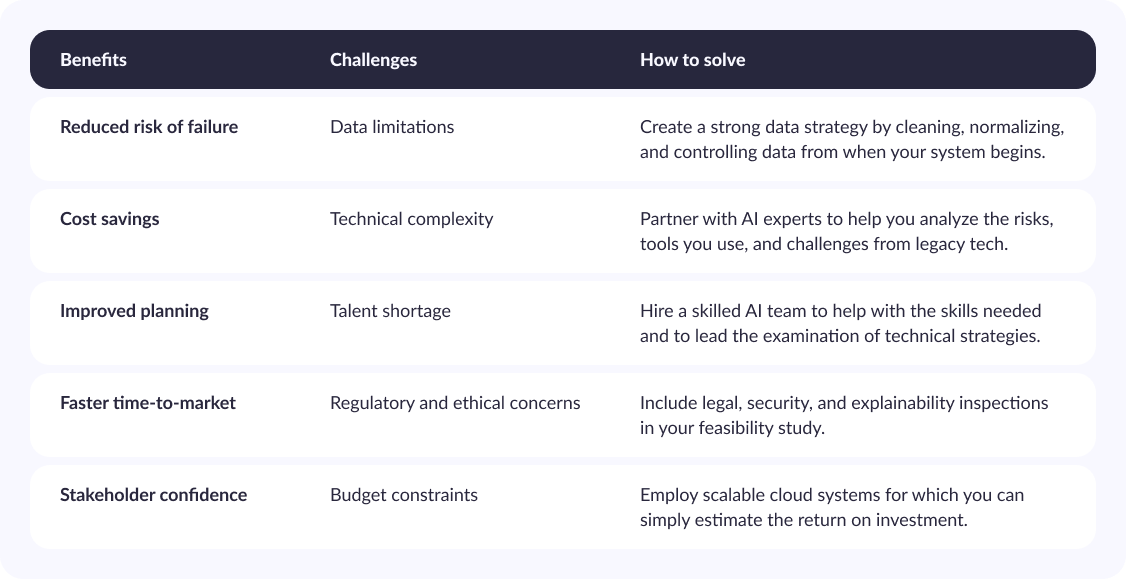Many artificial intelligence (AI) projects fail not because of bad ideas but due to missing foundational steps, mainly a lack of technical feasibility checks. Before starting development, many teams proceed without having a clear technical understanding that their solution is achievable. Projects launched without proper tools, skilled staff, or system compatibility often fail.
Early project feasibility evaluations protect against time delays, excessive expenses, and failure.
In this article, we explain what technological feasibility is, how to conduct a technical feasibility study, provide tips on writing one, and highlight key points to consider when aligning goals with what is technically possible.
What is technical feasibility?
A technical feasibility evaluation determines whether a project can be executed within existing hardware and software, technical competence, and network capabilities. The project's technical specifications must be evaluated to decide whether or not they fall within the organization's capabilities.
Technical feasibility studies for AI projects assess how to develop and integrate systems that suit organizational aims alongside existing technical restrictions.
Differences between technical and technological feasibility
Technical feasibility covers whether what you have now is enough to carry out the plan. Are you ready to execute? Do you have the right personnel, support, and steps to make the change effective?
The main concern regarding technological feasibility is whether the proposed technologies are mature and dependable. Just because a team has strong internal skills does not guarantee success if important tools have not yet been developed or executed.
Technical feasibility answers, “Can we create this product using our skills and resources?”
Technological feasibility asks, “Can this innovative technology withstand and meet expected outcomes?”
Each is needed to make investments safer and link what is expected with what can be achieved.
Technical feasibility factors
These factors determine the evaluation process of an AI project's technical feasibility:
Technical feasibility evaluation requires examining hardware equipment to confirm its ability to handle AI model processing needs, including storage and data consumption capabilities and computational power requirements.
It checks if current tools fit with existing systems, or if you need entirely new integrations.
The AI solution needs an assessment to expand its capacity and process the data volume, in preparation for future business growth. You assess the main parts of cloud infrastructure, database designs, and processing systems, and then technical teams review how well these systems can grow to meet demand.
Why a technical feasibility study is important
AI applications will become so sophisticated that every proposed project must be evaluated with higher precision. AI projects often involve layered hardware, software integrations, specialized models, and massive datasets that are hard to comply with. The technical feasibility study helps determine if your team has enough resources, such as infrastructure and technical expertise, to bring the project from conception to deployment.
But what happens when this step is overlooked? Without a thorough feasibility check, even well-intentioned AI projects can encounter major obstacles that derail their success.
Common risks of skipping the feasibility phase
Skipping the stage of checking technical feasibility can lead to significant risks. It may cost teams a lot to develop, and it often fails to function, clashes with existing systems, and misses technical requirements. This results in wasted development hours, budget overruns, and failures.
In the worst-case scenario, they would fail to detect vulnerabilities, mismatched tools, or an under-equipped team. Project managers who have completed a thorough feasibility study can identify these red flags early on and determine if the project aligns with the organization's goals.
How technical feasibility impacts success in AI projects
Often, an AI project fails simply because the technical challenges become evident when it is nearly too late to fix them. Through a technical feasibility study, you confirm that the chosen solution can be implemented.
The training of an AI model is not sufficient, as it requires much more. It takes strong data pipelines, resources that scale, immediate integration, and matching with current technology systems. If you don’t check these components early, the risk of experiencing late completion, overspending, or poor results becomes much higher.
A technical feasibility study addresses the necessary concerns:
How much data can the infrastructure cope with, and how fast can it manage processing?
Are the tools, APIs, and systems set for the model to work when deployed?
Can the architecture manage demand without losing security?
By using this process, you address goals and technical skills, avoid foreseen risks, and scale and earn ROI in the long term.


Thank you for Subscription!
Tips for writing a technical feasibility study
By examining the technical requirements, existing resources, and potential risks, project managers can reduce uncertainty and minimize the cost of errors. We prepared some steps and tips for writing a technical feasibility study:
1. Scope and objectives definition
The first step is defining the proposed project's scope. This involves delineating the outcomes, the metrics that will be targeted, and the products that will be delivered. KPIs can be measurable and help assess the feasibility of a proposed solution, aligning it with business goals. Well-defined objectives help determine if the project can be technically viable within the provided time frame and the available resources.
2. Technical requirements assessment
You need to evaluate the technical requirements to map out the development process. The scope of the work includes specifying the required hardware and software, assessing compatibility with the existing system, and projecting the solution’s scalability. Since many AI projects rely on powerful GPUs, scalable architectures, and robust data pipelines, this stage is essential during the feasibility assessment.
3. Technical expertise and resource evaluation
Determining resource requirements and assessing in-house availability of the technical skills are essential. Many AI initiatives have been halted because organizations lack the skills to train and deploy models efficiently. Writing a technical feasibility report is very important, and one of the aspects of your technical feasibility study is determining whether you need external partners or off-the-shelf tools. Training needs and the time frame should also be considered to prevent delays.
4. Infrastructure and scalability analysis
One of the questions you have to answer is whether the infrastructure supports the growth of the AI solution. Decide whether you want a cloud-based or on-premises setup based on your requirements and data security needs. Specifically, intelligent automation solutions that process large quantities of claims data or enable real-time decisions in insurers' operations require high scalability.
5. Risk assessment and mitigation
Determining problems in advance that have the potential to become significant roadblocks later allows for avoiding more serious concerns. When evaluating technical risks, consider vulnerability analysis, maintenance planning, and data privacy concerns. Check the system's security and whether it fits the changing compliance requirements.
6. Cost and timeline estimation
Cost and timeline analysis is an integral part of the overall feasibility study. It involves calculating infrastructure, development, and maintenance costs and estimating the time required to complete the project. Unexpected overruns are addressed with budget buffers, and the projected ROI is checked to determine if the project is economical. They can provide stakeholders with buy-in and allocate resources.

More from our blog
AI CRM: Transforming customer relationship management
Discover the best AI CRM software to improve customer relations and automate sales processes.
Read moreKey elements of a successful AI feasibility study
A technical feasibility study is not limited to having a well-defined structure and transparent methodology. To go beyond surface-level checks, identify the core elements directly affecting the project’s AI feasibility. These elements help the project manager evaluate technology feasibility and make informed, early decisions accurately.
1. Clear problem definition
Each study should start by identifying the specific business challenge the AI system is intended to solve. Without a well-defined problem, it is impossible to determine whether a given solution is correct. The study should evaluate a viable AI approach by determining whether AI is operationally feasible or if robotic process automation (RPA) or machine learning (ML) is viable.
2. Data availability and quality
Any AI model requires clear, high-quality, and relevant data to function effectively. The project's feasibility depends heavily on clean, structured, and representative data availability. Early in the data study, evaluating the volume and sources of the data is vital. Among other things, intelligent document processing, claims automation, and fraud detection are common securities. That’s why assessing technical feasibility is crucial at this step.
3. Algorithm selection and model complexity
The selection of appropriate algorithms affects the project's viability and scalability simultaneously. Each model needs to be analyzed according to its performance requirements and the expected level of explainability and interpretability.. Advanced infrastructure may also be required to finalize complex models, increasing technical and financial feasibility.
4. Technical infrastructure
Technical requirements evaluation involves finding the proper infrastructure to support development and deployment. It means analyzing hardware and software requirements, deciding if the device is compatible with current systems, and checking whether existing infrastructure can fulfill new needs. The use case may select the right benefits from cloud platforms, edge computing, or a hybrid environment.
5. Talent and expertise
Technical expertise is dependent upon finishing the project on time and within scope. Determine whether your team includes specialized AI talents such as data scientists or MLOps engineers. The feasibility study aims to help project managers determine whether the organization has the necessary qualified skills or if external support is required. Just as important is having the right technology; the more important thing is ensuring access to the right talent.
Benefits of conducting a technical feasibility study for AI
1. Reduced risk of project failure
By identifying the technical risks, infrastructure gaps, and data risks at the early stage, your organization can avoid costly mistakes and make the project viable. The structured feasibility study indicates whether the existing system can accommodate the AI solution or whether alternative solutions are necessary.
2. Cost savings
Teams can evaluate technical requirements before starting the development, optimizing the use of available resources. A feasibility study involves cost estimation and projected return on investment (ROI), which helps insurers manage budget expectations and reduce financial feasibility issues.
3. Improved project planning
By understanding the technical aspects of the project (i.e., compatibility, maintainability, and resource availability), project managers can better define the project timeframe and set reasonable milestones to minimize project handoffs between departments or individuals.
4. Faster time-to-market
The development process becomes much easier with a well-defined scope, prepared infrastructure, and aligned resources. This means that teams can complete the project more quickly and respond faster to market needs.
5. Better stakeholder confidence
Last, but not least, a benefit of intelligent automation is a well-documented technical feasibility report, which improves transparency and stakeholder trust. Proving the AI solution is technically feasible based on sound data and best practices can also help you secure buy-in or underwrite from decision-makers.
Challenges in conducting an AI feasibility study
1. Data limitations
In many cases, data is incomplete, unstructured, or siloed, making it difficult to assess its quality and volume. This challenge affects model training and severely impacts project feasibility.
2. Technical complexity
AI projects often involve complex algorithms, intelligent automation tools, and cloud infrastructure. Indeed, assessing all these variables requires deep technical expertise and an understanding of potential bottlenecks of technical debt from legacy systems.
3. Talent shortage
Internal expertise is a usual barrier. When a team lacks the required skills in-house, they find it challenging to determine technical requirements, identify key stakeholders, and so on, creating gaps in the feasibility report. In such situations, the dedicated AI team can fix the gaps by adding tech skills, enhancing the timeliness of the process, and delivering an actionable plan for following up.
4. Regulatory and ethical concerns
Compliance is non-negotiable, especially in industries such as capital markets. Any thorough feasibility assessment of how to study must also include evaluating AI models' security, explainability, and fairness, which are necessary to ensure that the survey meets legal and ethical standards.
5. Budget constraints
Even a technically sound project may be delayed by limited budgets, even the most promising ones. Making a realistic business case for AI implementation isn’t always straightforward. Cost estimates and resource availability are critical, especially when evaluating the feasibility of complex systems like robotic process automation and content services platforms.
How to overcome these challenges?
Being aware of what AI technology can and cannot do is very important before you start your development project. To explain this more easily, we’ve divided the key advantages, challenges, and solutions into a table:

1. Partner with AI vendors and experts
Hiring experienced AI vendors or consultants gives your company access to specialized expertise and best practices that may not exist in-house. These experts can help check available technical resources and guide you with solutions to reduce technical risks.
Writing a technical feasibility study may also require contributions from external parties. These efforts must be implemented through a structured process that includes all technical details.
2. Scalable infrastructure adoption
Cloud-based or hybrid architectures offer the flexibility and scalability to support AI projects. This is especially important for evaluating the feasibility of complex AI systems with enormous processing power, vast storage, and easy integration with existing systems. Cloud solutions also reduce capital investment and facilitate faster production, ensuring the project is completed within the stipulated time and budget.
3. Data strategy focus
When there isn’t much or reliable information, building a strong data strategy is necessary. Measures should be taken to clean, normalize, and organize data, as well as decide on effective governance methods to maintain high quality at the source. A good foundation of clean data is vital for any machine learning or automated solution to work successfully.
How does our AI feasibility study transform our clients’ AI projects?
BoosterPrep: AI avatar interviewer
For BoosterPrep, we aimed to test whether we could program an AI avatar to conduct live online interviews and speak with people in real time.
Our feasibility study gave us some significant findings:
Technology integration. We found that bringing together lip-sync technology, language models from OpenAI, and voice synthesis allowed us to solve the problem.
Cost limitations. Generating audio responses was not costly, but producing video interviews cost almost as much as hiring a live interviewer. As a result, companies began to worry about ROI.
Problems associated with user experience. Even the tiniest issues with how the video was displayed reduced how good the avatar looked and how impressed the user was.
So, we used audio bots as our leading solution. Beforehand, a bot asked certain questions, and if a user chose an option, the system reacted appropriately and continued the interaction. Because of this approach, complexity was lowered, costs were reduced, and users continued enjoying a good experience.
Image quality enhancement for a food delivery app
The aim of this project was to create a neural network that allows for enhancing and retouching of food images to a level comparable to that of a professional photo. editor
Based on the feasibility analysis, we identified several key findings:
Complexity of real-world editing. After reviewing retoucher workflows, we discovered that retoucher tasks involve complex operations beyond simple color correction, such as item removal, historical image enhancement, and upgrades.
Strategy shift. We decided against training a neural network from scratch, as the scope extended far beyond basic enhancements. Instead, based on the retoucher’s process, we developed the pipeline into separate stages: background removal, background replacement, resolution improvement, and color correction.
Solution design. For each stage, we selected dedicated third-party APIs and proposed an API-based solution architecture. This modular approach enabled us to meet quality requirements efficiently without the high resource costs of training a full end-to-end model.
Conclusion
A thorough technical feasibility study is necessary to confirm that the project can be implemented using available resources by evaluating technical requirements, system compatibility, and the scale of the required solutions.
Such assessments reduce the risk of failure by identifying potential technical challenges, resource gaps, and system vulnerabilities. They provide stakeholders with clear insights into project feasibility, costs, and constraints.
As a result, you get better planning, faster implementation, and strong confidence in project delivery. Whether you're considering an e-commerce platform, a customer service chatbot, or any other AI-powered app, contact Geniusee to initiate a feasibility analysis tailored to your AI project for long-term success!
FAQs
What is a technical feasibility examination?
A technical feasibility study evaluates whether a proposed venture can evolve effectively with the available era, infrastructure, and technical knowledge. It specializes in assessing hardware and software requirements, compatibility with existing structures, and scalability. This feasibility evaluation helps decide whether the assignment is technically feasible and identifies any technical risks impacting the development system.
What are the key elements of a technical feasibility study?
A complete technical feasibility analysis includes scope definition, technical necessities assessment, infrastructure and scalability analysis, and resource assessment. It additionally covers risk identity, price estimation, and timelines. For AI tasks, this includes reviewing the provision of facts, hardware and software compatibility, talent availability, and ensuring alignment with business needs, which are essential for task success and stakeholder confidence.
How does a technical feasibility study reduce project risk?
A feasibility examination identifies technical dangers at early stages, enabling venture managers to prepare mitigation strategies before development begins. It highlights troubles such as insufficient information, infrastructure obstacles, or gaps in technical knowledge. Understanding those risks prematurely allows the team to make informed decisions, allocate resources more effectively, and increase the chances of a successful AI implementation while avoiding expensive delays.





















